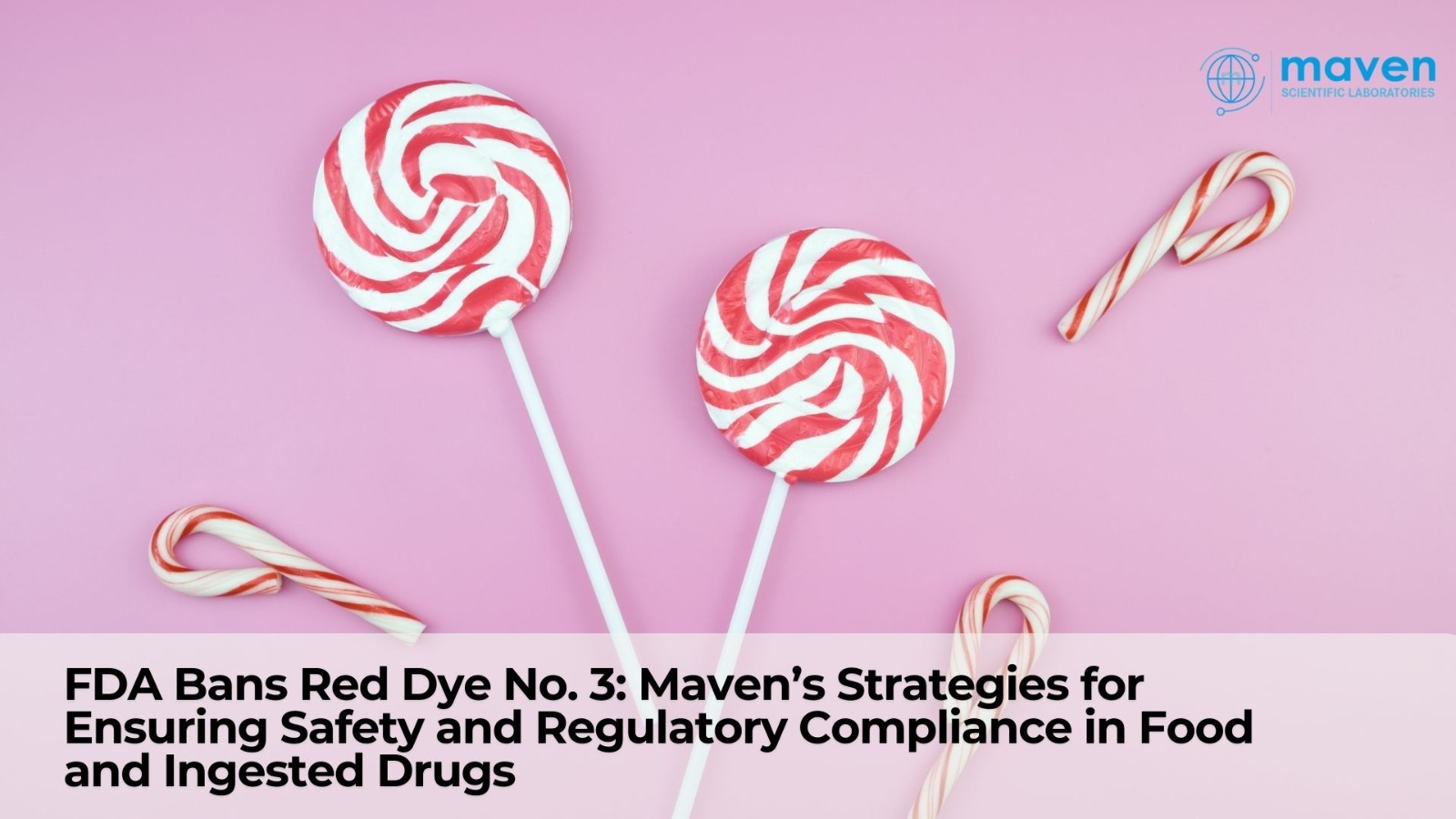FDA Bans Red Dye No. 3: Maven’s Strategies for Ensuring Safety and Regulatory Compliance in Food and Ingested Drugs
January 17, 2025
The U.S. Food and Drug Administration (FDA) recently announced a landmark decision to ban the use of Red Dye No. 3 in food, beverages, and ingested drugs. This synthetic colour additive, also known as erythrosine, has been under scrutiny for decades due to its association with cancer in animal studies. The decision, influenced by a 2022 petition from advocacy groups like the Centre for Science in the Public Interest and the Environmental Working Group, aligns with the Delaney Clause of the Federal Food, Drug, and Cosmetic Act (FFDCA), which prohibits carcinogenic substances in food and drugs.
Manufacturers must phase out Red Dye No. 3 in food by January 2027 and in ingested drugs by January 2028, signalling a significant shift in industry practices. This regulatory change highlights the need for vigilance and adaptability to ensure consumer safety and compliance.
Maven, a leader in toxicological risk assessment and regulatory services, plays a critical role in assisting industries to navigate this transition seamlessly. Here’s how Maven supports businesses affected by the FDA’s decision, along with the relevant regulatory considerations:
1. Toxicological Risk Assessments
Red Dye No. 3’s carcinogenic potential has necessitated the identification of safer alternatives. Maven’s team of toxicologists conducts detailed assessments to evaluate the safety and regulatory compliance of substitute ingredients, such as Red Dye No. 40 and natural alternatives like beetroot powder or carmine. Using advanced techniques like Quantitative Structure-Activity Relationship (QSAR) modelling and read-across methods, Maven ensures that these alternatives meet both FDA safety standards and consumer expectations.
Regulatory Note:
All colour additives used as replacements must comply with FDA’s Colour Additive Regulations outlined in 21 CFR Part 73, 74, and 82, specifying usage conditions, safety assessments, and labelling requirements.
2. Regulatory Compliance Support
Navigating evolving FDA regulations can be daunting for manufacturers. Maven provides end-to-end compliance solutions to help businesses meet the FDA’s updated requirements. This includes reformulating products, revising labelling, submitting updated formulations to the FDA for review, and ensuring all manufacturing practices align with the new standards.
Regulatory Note:
Compliance with Good Manufacturing Practices (GMP) under 21 CFR Part 117 (food safety) and 21 CFR Part 211 (pharmaceuticals) is critical during product reformulation.
3. Reformulation and Product Development
Reformulating products to replace Red Dye No. 3 is a complex process. Maven collaborates with R&D teams to identify, validate, and integrate suitable colour additives that meet both sensory and regulatory criteria. Maven also ensures that these alternatives maintain the aesthetic and functional qualities of the product, such as flavour stability and visual appeal.
Regulatory Note:
Any new formulation must be approved through an FDA Food Additive Petition (FAP) or a Colour Additive Petition (CAP) if it involves a new or previously unapproved substance.
4. Safety Data Sheet (SDS) Updates
Changes in ingredient composition necessitate revisions to Safety Data Sheets (SDS). Maven assists in preparing accurate SDS documents that comply with Occupational Safety and Health Administration (OSHA) Hazard Communication Standards (29 CFR 1910.1200), ensuring regulatory transparency and workplace safety.
5. Consumer Education and Communication
The FDA’s ban has heightened consumer awareness of ingredient safety. Maven helps businesses craft clear, accurate, and engaging communication materials to educate consumers about the changes. This includes updates to product labelling, website content, and social media outreach that highlight the company’s commitment to safety and compliance.
Regulatory Note:
Product labelling must comply with FDA guidelines under 21 CFR Part 101 (food labelling) and 21 CFR Part 201 (drug labelling).
6. Global Compliance Strategies
For companies exporting to the U.S. or other markets with similar regulatory frameworks, Maven provides tailored compliance solutions to meet global requirements. This includes ensuring alignment with international standards, such as the European Food Safety Authority (EFSA) guidelines for food additives and ICH Q3D for pharmaceuticals.
7. Auditing and Quality Assurance
To ensure ongoing compliance, Maven conducts rigorous audits of manufacturing facilities, processes, and documentation. By identifying potential gaps and recommending corrective actions, Maven prepares businesses for FDA inspections and third-party audits.
Regulatory Note:
Audits must consider compliance with 21 CFR Part 11 for electronic records and FDA Form 483 observations for pre-approval inspections.
Why Choose Maven?
With decades of experience in toxicology, regulatory affairs, and product safety, Maven is uniquely positioned to assist industries in navigating the FDA’s Red Dye No. 3 ban. Maven’s interdisciplinary approach ensures businesses achieve compliance while maintaining consumer trust and product quality.
Conclusion
The FDA’s decision to ban Red Dye No. 3 represents a milestone in prioritizing consumer safety. However, it also presents significant challenges for manufacturers. Maven’s comprehensive services, backed by a thorough understanding of regulatory frameworks, enable businesses to adapt effectively to these changes, ensuring compliance, product quality, and consumer confidence.
By partnering with Maven, companies can transform regulatory challenges into opportunities for innovation, reinforcing their commitment to safety and excellence in an ever-evolving marketplace.


Post a comment